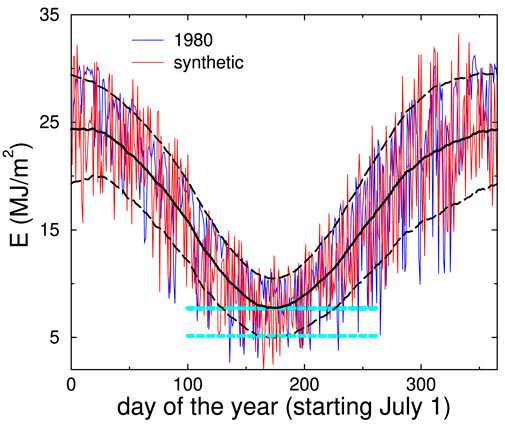This article has been reviewed according to Science X's editorial process and policies. Editors have highlighted the following attributes while ensuring the content's credibility:
fact-checked
trusted source
proofread
Doing the math on a solar-powered future

Physicist Anders Carlsson, at Washington University in St. Louis, and Sid Redner of the Santa Fe Institute have created a new mathematical model to describe the most reliable, efficient and cost-effective way to harness solar power.
Their calculations, recently published in the journal Frontiers in Energy Research, show that small improvements in energy generation and storage could have huge impacts on the overall reliability of a solar-powered grid.
Using 40 years of solar data from the St. Louis region, Carlsson and Redner ran calculations over millions of hypothetical years to determine the optimal mix of power generation and storage to build a reliable grid that runs on renewable energy. Such a system is many years from reality, and Carlsson notes that a renewable grid in St. Louis would have to combine solar and wind power.
Still, the physicists found some room to be optimistic. Their analysis showed that, with only modest system improvements, a solar-powered grid could be extremely stable.
"Reliability improves exponentially if you increase either the generation capacity or the storage," said Carlsson, a professor of physics in Arts & Sciences.
Storage capacity is crucial because sunshine can be in short supply during the winter in many parts of the country, including St. Louis. That means that any solar-powered energy system must include batteries that can supply energy on relatively dark days.
Building better batteries is an important mission for scientists at WashU and elsewhere. Advances in battery technology could certainly help revolutionize the power grid, but Carlsson and Redner's calculations show that reducing the costs of solar panels could have a relatively greater impact on the efficiency of the overall system.
In St. Louis, the sun is reliable enough to power the grid for the great majority of the year, meaning that most of the energy will come directly from the power plant, not a battery. "But because the science of batteries offers more potential for game-changing discoveries, battery research should still be a priority," he said.
Carlsson said the math of renewable energy points to another important lesson: The search for perfection might be counterproductive. A hypothetical system that runs exclusively on renewable solar and wind power would be significantly more expensive than a renewable system that used small amounts of natural gas as a backup, he said.
He estimated that, with current technology, a 100% renewable system that powered St. Louis could cost $130,000 per household. A system that was 95% or 99% renewable, however, could be in the range of $80,000 to $90,000.
"Extremely highly renewable systems are very expensive," Carlsson said. "If we can get to 99% renewable in 10 years, versus 100% renewable in 30 years, we'd better figure out how to get to that 99%."
More information: Anders E. Carlsson et al, Optimal storage for solar energy self-sufficiency, Frontiers in Energy Research (2023). DOI: 10.3389/fenrg.2023.1098418



















